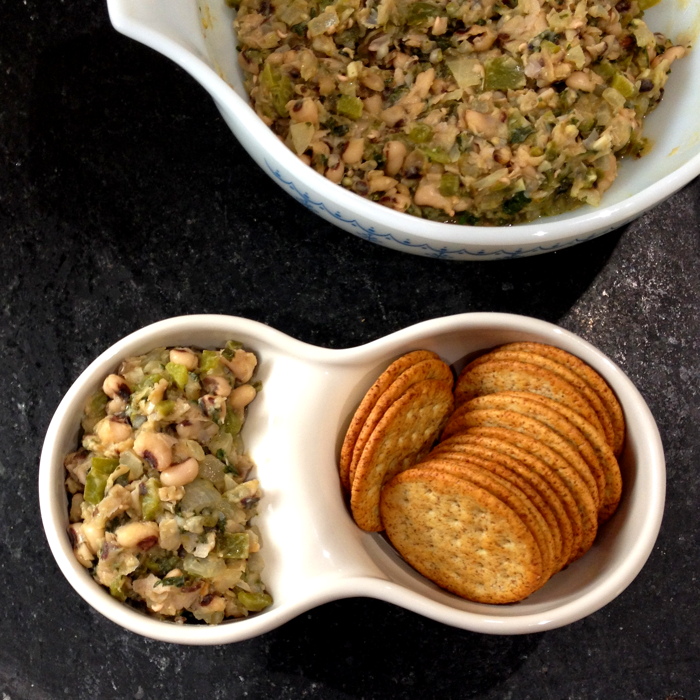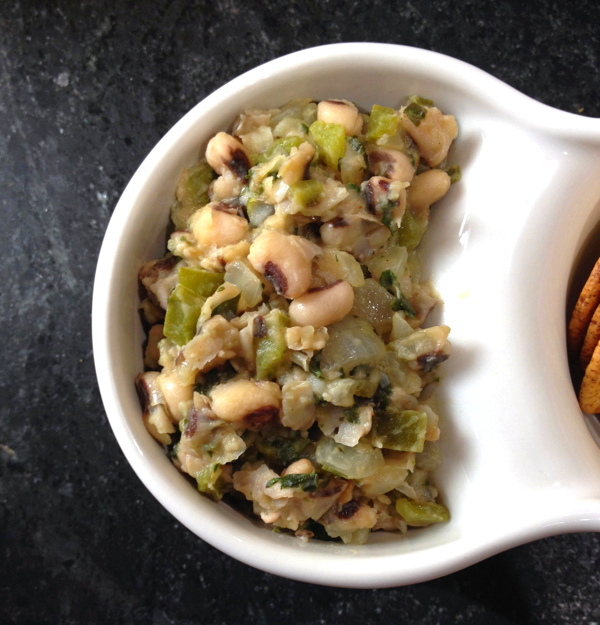Southwestern Caviar (also known as “Texas Caviar” in some circles), is a healthy and vegan appetizer, or snack, or side dish, that’s been around since at least the 1940’s. Black-eyed peas combine with peppers, onions, and a tangy dressing, making this a versatile and popular addition to your table as “good luck” food to celebrate the New Year, or Game Day snack to round out the chips and dips!

Southwestern Caviar can be served cold, warm as a side dish, but for us, it’s best at room temperature, which makes it ideal for “grazing” during Super Bowl and Oscar-viewing parties. It travels really well, and would make a great contribution to pot-lucks! It also keeps very well in a sealed container in the refrigerator – it gets even better with a day or two of melding time – so you can make it several days in advance. Which is a good thing, since we need to get started by soaking, then cooking, those black-eyed peas.
This recipe makes a little over a quart, and may be doubled if you’re expecting a large crowd.

Southwestern Caviar
Ingredients:
- 8 oz dried black-eyed peas
- About 2 quarts of water for soaking
- About 2 more quarts of water for cooking
- 2 Tbs. vegetable oil (corn, peanut, canola, etc. – not olive oil) for frying
- 1 large onion, chopped medium
- 1 large bell pepper – seeds and ribs removed – chopped medium
- 1 – 2 jalapeño pepper(s)* – seeds and ribs removed – chopped fine
- 2 bay leaves
- 2 medium or large cloves of garlic, smashed then chopped fine
- 2 Tbs. wine vinegar or balsamic vinegar*
- 1/8 – 1/4 tsp. chili powder*
- 2 Tbs. chopped parsley or cilantro
- 2 – 4 Tbs. vegetable oil (same type you used for frying), as needed
- Salt and ground black pepper to taste
Preparation:
Rinse and pick through the black-eyed peas, removing any loose skins. Place the rinsed peas in a 4-6 quart pot, add the 2 quarts (8 cups) of water. Cover the pot with its lid and cook on high heat to a boil. Allow to boil for 2 minutes, then turn off the heat and allow the peas to soak in the same water for at least 2 hours, or even overnight.
Drain the black-eyed peas, put them back in the pot, and add the fresh 2 quarts (8 cups) of water. Cover the pot with its lid and heat on high until the water boils. Reduce heat to low, and allow the peas to simmer for about 1 hour, or until tender. The peas should still retain their shape – firm, but starchy and creamy in texture – not crunchy! The actual amount of time necessary to cook the black-eyed peas depends a lot on their age. Older ones will take a bit longer, fresher ones may take a bit less time. Start tasting at around the 45 minute mark. When they’re cooked completely, drain and set aside.
Heat the 2 Tbs. of oil in a large saute pan over medium-high heat. When hot, add chopped onion, bell pepper, jalapeño, bay leaves, and garlic. Reduce heat to medium and, stirring occasionally, cook the vegetables until soft, but not browned. Remove the bay leaves.
Put the cooked and drained black-eyed peas into a large bowl, then add the sauteed vegetables. Add the vinegar, chili powder, chopped parsley (or cilantro), and 2 Tbs. of the additional oil. Start with about 1/2 tsp of salt and 1/8 – 1/4 tsp. of black pepper. Mix gently, but completely. Taste. Is it too dry? Add a bit more oil. Need more salt? Add a pinch or two. Mix again.
Serve with crackers, tortilla chips, or dipper of your choice.
If not serving right away, store in a sealed container in the refrigerator, but allow to come to room temperature for serving. This will keep in the fridge for a week. Maybe longer, but we never have it around long enough to find out. 😉

~~~~~~~~~~
*Notes:
You may substitute Hatch chile peppers for the jalapeños, if you have some roasted and stored in your freezer. Taste your peppers before deciding if you’re going to use more than one. Grocery store peppers are frequently “dumbed-down” in the heat department. I’ve had jalapeños that were no hotter than bell peppers, and others that were really hot (to my palate). As we said when I worked in the legal profession, once upon a time, govern yourselves accordingly.
Regarding the vinegar: I’ve used different kinds of vinegar in this dish over the years: red wine, white wine, cider, and balsamic. They’re all good, so use what you have and what you like. Don’t use regular white vinegar. That’s insulting. Now, if you’d like to add another layer of flavor, try using the Serrano Chile Honey Balsamic Vinegar by Honey Ridge Farms. It just takes this recipe to a whole new level. And, no, they’re not paying me. So there. I’m just trying to broaden your horizons. 😀
Chili (or chile, if you prefer) powder: Again, I’ve used a number of different chili powders over the years, so use what you like. Hatch chile powder, ancho chile powder, chipotle chile powder – all are terrific. We don’t use cayenne chili powder in our house, because the husband doesn’t like that the heat heads straight for the back of your throat. If you like it, though, use it.
Strict vegans (or “philosophical vegans”, as I call them) should not use the honey balsamic vinegar, because, honey. But the rest of you will love it. Also, be kind to the gluten-intolerant and serve this with gluten-free dippers. We’re not sensitive to gluten here, but our favorite chip-of-choice for this is made by Riceworks. You’ll find them in the regular snack aisle, and everyone loves them. (No, dammit, they’re not paying me, either. They don’t even know me.)
~~~~~~~~~~


This is the ONLY way I eat black eyed peas. 🙂 Looks great, dear!
Thanks, Meagan! 🙂